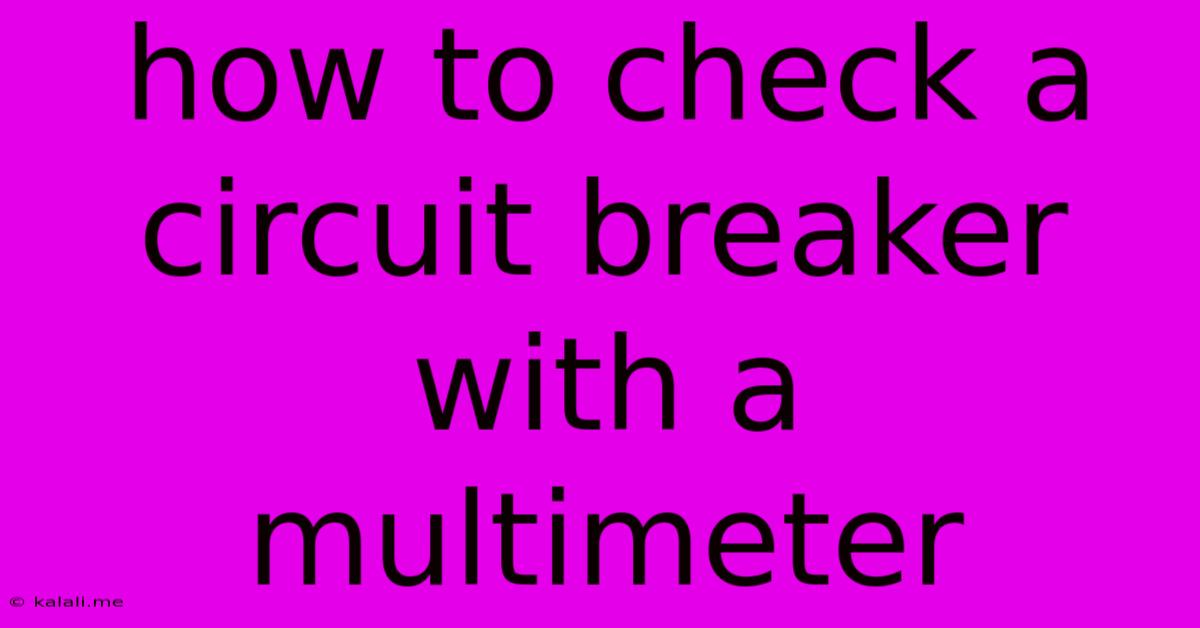How To Check A Circuit Breaker With A Multimeter
Kalali
Jun 04, 2025 · 3 min read

Table of Contents
How to Check a Circuit Breaker with a Multimeter: A Comprehensive Guide
Meta Description: Learn how to safely and effectively test your circuit breakers using a multimeter. This guide covers different scenarios and troubleshooting steps for identifying faulty breakers.
Circuit breakers are essential safety devices in your electrical system, protecting your home and appliances from power surges and short circuits. Knowing how to check a circuit breaker with a multimeter is a valuable skill for homeowners and DIY enthusiasts, allowing for quick troubleshooting and preventing potential electrical hazards. This comprehensive guide will walk you through the process, explaining different scenarios and what the multimeter readings indicate. Safety is paramount, so always prioritize your well-being and follow the instructions carefully.
Safety First: Essential Precautions
Before you even touch your multimeter, remember these crucial safety steps:
- Turn off the main power: This is the most important step. Locate your main breaker box and switch off the main breaker. This completely disconnects power to your entire electrical system, eliminating the risk of electric shock.
- Use insulated tools: Always use insulated screwdrivers and pliers when working with electrical components.
- Wear safety glasses: Protecting your eyes from potential sparks or debris is crucial.
- Work with a partner: If possible, have someone assist you. An extra set of hands can be incredibly helpful and improve safety.
- Know your breaker: Understand the type of circuit breaker you have. Different types might require slightly different testing procedures.
Tools You'll Need:
- Multimeter: A digital multimeter (DMM) is essential for testing circuit breakers. Ensure it's properly calibrated and in good working condition.
- Screwdriver (Phillips and flathead): To access the breaker terminals.
Testing a Circuit Breaker: Step-by-Step Guide
This guide assumes you're checking a breaker suspected of being faulty. Never test a breaker that is currently tripping or showing signs of arcing.
-
Identify the circuit breaker: Determine which breaker you want to test. It’s often helpful to switch off the breaker beforehand as a precaution.
-
Access the breaker terminals: Carefully remove the breaker from the panel. Consult your breaker panel's instruction manual if needed. Many breakers have terminals that can be accessed without removing the breaker entirely.
-
Set your multimeter: Set your multimeter to measure resistance (Ω).
-
Test for continuity: Place the multimeter probes on the two terminals of the breaker. You should get a reading close to zero ohms. This indicates a good connection and that the breaker's internal mechanism is intact and the breaker is closed. A high resistance reading or an "OL" (overload) suggests a fault within the breaker.
-
Test for open circuit: Turn the breaker to the "off" position. Retest the continuity. You should now get an infinite reading (OL) on your multimeter. This signifies that the breaker is successfully interrupting the circuit. A low resistance reading indicates a fault.
-
Check for shorts: With the breaker in the "off" position, place one probe on each terminal. Observe the reading. A near zero reading indicates a short-circuit inside the breaker.
-
Repeat the tests: Repeat steps 4-6 a few times to ensure consistent results.
Interpreting Your Multimeter Readings:
- Near-zero ohms (0Ω): Indicates a good connection and a closed circuit (when the breaker is ON).
- Infinite ohms (OL): Indicates an open circuit (when the breaker is OFF).
- High resistance (significantly above 0Ω): Suggests an internal fault or a loose connection within the breaker.
- Low resistance (when the breaker is OFF): Indicates a short circuit within the breaker.
When to Replace a Circuit Breaker:
If your multimeter readings indicate any issues—high resistance, low resistance when OFF, or inconsistent readings—it's best to replace the circuit breaker. A faulty breaker can pose a significant fire hazard.
Conclusion:
Checking a circuit breaker with a multimeter is a straightforward yet crucial task for maintaining your home's electrical safety. By following these steps carefully and understanding the multimeter readings, you can confidently identify and address potential problems before they escalate. Remember, always prioritize safety! If you're unsure about any aspect of this process, consult a qualified electrician.
Latest Posts
Latest Posts
-
Does Biology View The Body As A Machine
Jun 06, 2025
-
How To Get Rid Of Grass Clippings
Jun 06, 2025
-
How Do You Change Default Pi User
Jun 06, 2025
-
Do You Have To Change Rotors When Replacing Brake Pads
Jun 06, 2025
-
Can You Use A Schrader Tube On A Presta Rim
Jun 06, 2025
Related Post
Thank you for visiting our website which covers about How To Check A Circuit Breaker With A Multimeter . We hope the information provided has been useful to you. Feel free to contact us if you have any questions or need further assistance. See you next time and don't miss to bookmark.